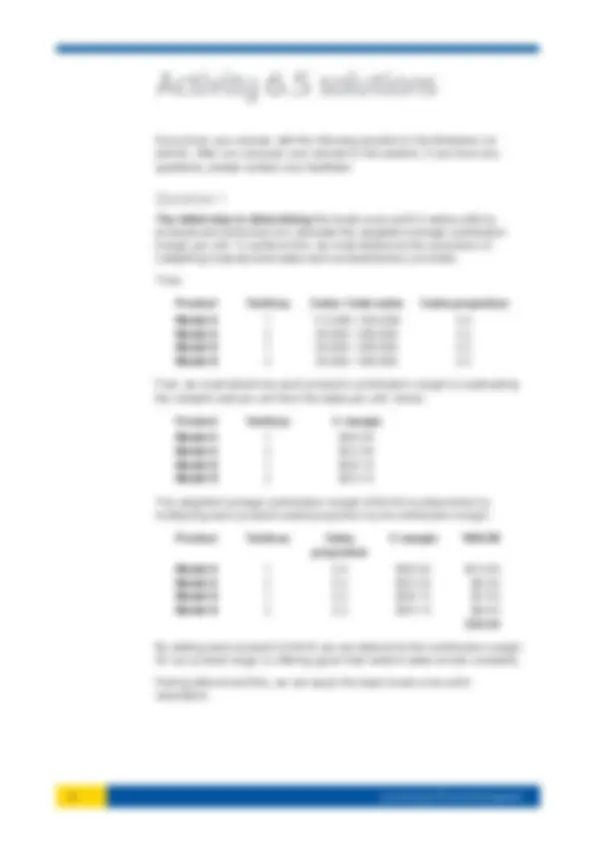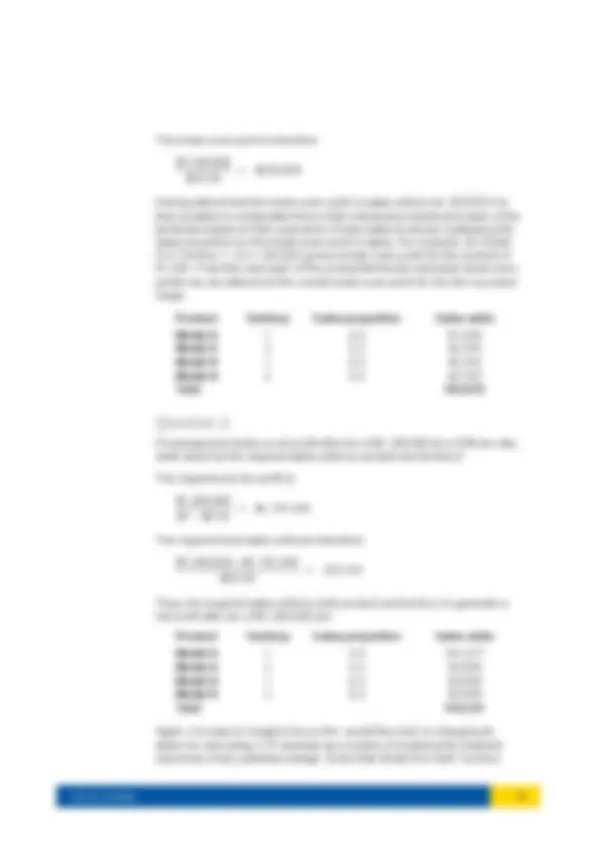





Study with the several resources on Docsity

Earn points by helping other students or get them with a premium plan


Prepare for your exams
Study with the several resources on Docsity

Earn points to download
Earn points by helping other students or get them with a premium plan
Community
Ask the community for help and clear up your study doubts
Discover the best universities in your country according to Docsity users
Free resources
Download our free guides on studying techniques, anxiety management strategies, and thesis advice from Docsity tutors
An example of how management at Brisbane Ltd uses CVP (Cost-Volume-Profit) data to decide whether to change the product/sales mix in two different territories. estimates of sales units, selling prices, variable and fixed costs for two products (Model A and Model B) in each territory. The goal is to determine the break-even point and required sales units to achieve a desired net profit after tax.
What you will learn
Typology: Schemes and Mind Maps
1 / 6

This page cannot be seen from the preview
Don't miss anything!




Unit 6.5 Activities 1
The Brisbane Ltd activity introduces a multi-product setting to the application of CVP analysis. The activity provides an example of how management may use CVP data to decide whether a firm offering two different types of products in two separate geographical locations uses CVP data to decide whether to change its product/sales mix. Brisbane Ltd sells two products (models A and B) in two territories. The following estimates of sales units, selling prices, and variable and fixed costs have been prepared for the coming year ending 30 June. Product territory Model A 1 Model A 2 Model B 1 Model B 2 Forecasted sales units 112,000 56,000 56,000 56, Selling price $100.00 $100.00 $118.00 $118. Total variable mfg cost per unit 50.00 50.00 60.00 60. Other variable costs per unit Delivery costs 4.00 8.00 6.00 12. Warehousing 2.00 2.00 4.00 4. Market administration (@ 2%) 2.00 2.00 2.36 2. General administration (@ 4%) 4.00 4.00 4.72 4. Settlement discount 1.00 0.50 1.18 0. Bad debts 0.50 1.00 0.59 1. Total variable costs per unit 63.50 67.50 78.85 84. Unit contribution margin 36.50 32.50 39.15 33. Planned fixed costs are as follows: Machining department – fixed overhead $1,000,
2 Accounting and Financial Management Based on the above, the following summarised budgeted profit statement has been prepared: Brisbane Ltd Budgeted profit summary (’000s omitted) Product territory Model A 1 Model A 2 Model B 1 Model B 2 Total Forecasted sales units 112 56 56 56 280 Sales revenue $11,200 $5,600 $6,608 $6,608 $30, Variable mfg cost 5,600 2,800 3,360 3,360 15, Other variable costs 1,512 980 1,055.60 1,391.60 4,939. Total variable costs 7,112 3,780 4,415.60 4,751.60 20,059. Contribution 4,088 1,820 2,192.40 1,856.40 9,956. Fixed costs: Manufacturing 3, Selling, general and administration 2, Financing 558 Total fixed costs 7, Operating profit before tax 2,708. Income tax (@ 33%) 893. Net profit 1,814.
4 Accounting and Financial Management
Now check your answer with the following solution to the Brisbane Ltd activity. After you compare your answer to the solution, if you have any questions, please contact your facilitator.
The initial step in determining the break-even point in sales units by products and territories is to calculate the weighted average contribution margin per unit. To achieve this, we must determine the proportion of (weighting towards) total sales each product/territory provides. Thus: Product Territory Sales / total sales Sales proportion Model A 1 112,000 / 280,000 0. Model A 2 56,000 / 280,000 0. Model B 1 56,000 / 280,000 0. Model B 2 56,000 / 280,000 0. First, we must determine each product’s contribution margin by subtracting the variable cost per unit from the sales per unit, hence: Product Territory C-margin Model A 1 $36. Model A 2 $32. Model B 1 $39. Model B 2 $33. The weighted average contribution margin (WACM) is determined by multiplying each product’s sales proportion by its contribution margin. Product Territory Sales proportion C-margin WACM Model A 1 0.4 $36.50 $14. Model A 2 0.2 $32.50 $6. Model B 1 0.2 $39.15 $7. Model B 2 0.2 $33.15 $6. $35. By adding each product’s WACM we can determine the contribution margin for our product range or offering (given that relative sales remain constant). Having determined this, we can apply the basic break-even point calculation.
Unit 6.5 Activities 5 The break-even point is therefore $7,248, = $203, $35. Having determined the break-even point in sales units to be 203,825 it is then possible to extrapolate this to both individual products and each of the territories based on their proportion of total sales by simply multiplying the sales proportion by the break-even point in sales. For example, for Model A in Territory 1, 0.4 × 203,825 gives a break-even point for the product of 81,530. If we then add each of the product/territories individual break-even points we can determine the overall break-even point for the firm’s product range. Product Territory Sales proportion Sales units Model A 1 0.4 81, Model A 2 0.2 40, Model B 1 0.2 40, Model B 2 0.2 40, Total 203,
If management desire a net profit after tax of $1,200,000 at a 33% tax rate, what would be the required sales units by product and territory? The required pre-tax profit is: $1,200, = $1,791, $1 − $0. The required total sales units are therefore: $7,248,000 + $1,791, = 254, $35. Thus, the required sales units by both product and territory to generate a net profit after tax of $1,200,000 are: Product Territory Sales proportion Sales units Model A 1 0.4 101, Model A 2 0.2 50, Model B 1 0.2 50, Model B 2 0.2 50, Total 254, Again, it is easy to imagine how a firm would then look to changing its sales mix and using CVP analysis as a means of modeling the financial outcomes of any potential change. Given that Model B in both Territory